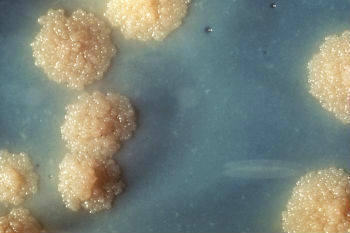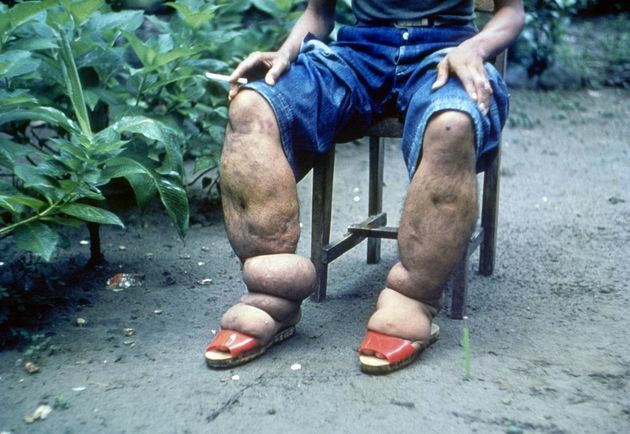Tuberculosis, also called pulmonary phthisis, is a infectious disease caused by bacteria.
The scientific name of the bacillus is Mycobacterium tuberculosis, also called Koch's Bacillus (BK).
It gets its name because it was discovered by the German physician and bacteriologist Heinrich Hermann Robert Koch, in 1882.
 Mycobacterium tuberculosis
Mycobacterium tuberculosis
The main characteristic of tuberculosis is the involvement of one of Organs most important organs of the respiratory system: the lung. Coughing fits may be accompanied by pus and blood.
In addition to the lung, tuberculosis can affect other organs (larynx, intestines, kidneys, skin, etc.), bones, joints and tissues of the human body, making it a very serious disease. If left untreated, it can lead to death.
This disease is very old and even before the Christian Era it affected many people. Previously, it was called the “grey plague”.
Only in the 19th and 20th centuries, due to the number of infected people, the disease gained international attention. Remember that it is considered one of the most serious and deadly diseases in the world.
 World Tuberculosis Map. Source: World Health Organization (WHO), 2007
World Tuberculosis Map. Source: World Health Organization (WHO), 2007
Tuberculosis in Brazil
In Brazil, tuberculosis cases are still evident, which makes it a serious public health problem, although it has decreased in recent years due to vaccination campaigns. According to the Ministry of Health (2014):
“In Brazil, tuberculosis is a serious public health problem, with deep social roots. Each year, approximately 70,000 new cases are reported and 4,600 deaths occur as a result of the disease. Brazil ranks 17th among the 22 countries responsible for 80% of the total number of tuberculosis cases in the world.
Over the past 17 years, tuberculosis has decreased by 38.7% in the incidence rate and 33.6% in the mortality rate.”
Diagnosis
The diagnosis of the disease is made through a test called bacilloscopy. In addition, a chest x-ray can identify tuberculosis.
Learn more about the topic by reading the articles:
- Bacteria
- Respiratory system
- Lung
Types of Tuberculosis
In addition to pulmonary tuberculosis, there are other types of tuberculosis. are called extrapulmonary tuberculosis and affect other organs in the human body.
- Pulmonary Tuberculosis: most common form of the disease and affecting the lungs.
- Pleural Tuberculosis: Occurs by the accumulation of secretion in the pulmonary pleura, that is, a membrane that surrounds the lung. Causes rib cage pain and shortness of breath.
- Ganglion Tuberculosis: when the disease bacillus reaches the lymph nodes, that is, small organs that act in defense of the body. This type is very common in HIV-positive patients.
- Bone Tuberculosis: also called "Pott's Disease" (Pott's Disease) or "Vertebral Tuberculosis", this type of tuberculosis affects the bones (above all, the spine) causing pain and inflammation.
- Cutaneous Tuberculosis: it is one of the most serious forms of the disease. It reaches the bloodstream causing damage to the skin.
Tuberculous Meningitis
When the bacteria reach the meninges, that is, membranes that protect the central nervous system, it is called tuberculous meningitis.
Streaming
Tuberculosis is a contagious disease which is transmitted through contact with infected people.
The patient's secretions (sneezing, saliva, coughing, etc.) expel the bacteria and, therefore, closed places with large agglomerations should be avoided.
In addition to humans, the disease also affects animals. Note that people who have the virus AIDS and diseases such as diabetes are more likely to get the bacteria.
Symptoms
The main symptoms of tuberculosis are:
- Fever
- Chills
- Fatigue
- Pallor
- Sweating
- hoarseness
- Lack of appetite
- slimming
- Persistent cough with discharge
- Chest pain
- difficulty breathing
- Muscle aches
- malaise
Treatment
To treat tuberculosis, the person with the disease must remain at rest, eat well, drink plenty of fluids and take antibiotics. It is worth remembering that the treatment for tuberculosis is long and can last more than 6 months.
It is advisable that those infected remain isolated in the first period of treatment, avoiding the proliferation of the bacillus.
Find out what were the Largest pandemics in human history.
Prevention
One of the most effective ways to prevent tuberculosis is taking the BCG vaccine (Bacille Calmette and Guerin) in a single dose. It is mandatory and taken during childhood.
Good nutrition, daily exercise practices and healthy habits strengthen our immune system, leaving our body less susceptible to the onset of disease.
In addition, avoiding places with intense agglomeration can be an alternative, as it is a contagious disease.
Did you know?
The BCG vaccine is given to the right arm and usually causes a lifelong scar. It should not be taken by people who have the HIV virus and who have symptoms.
Know about the Diseases caused by bacteria.


